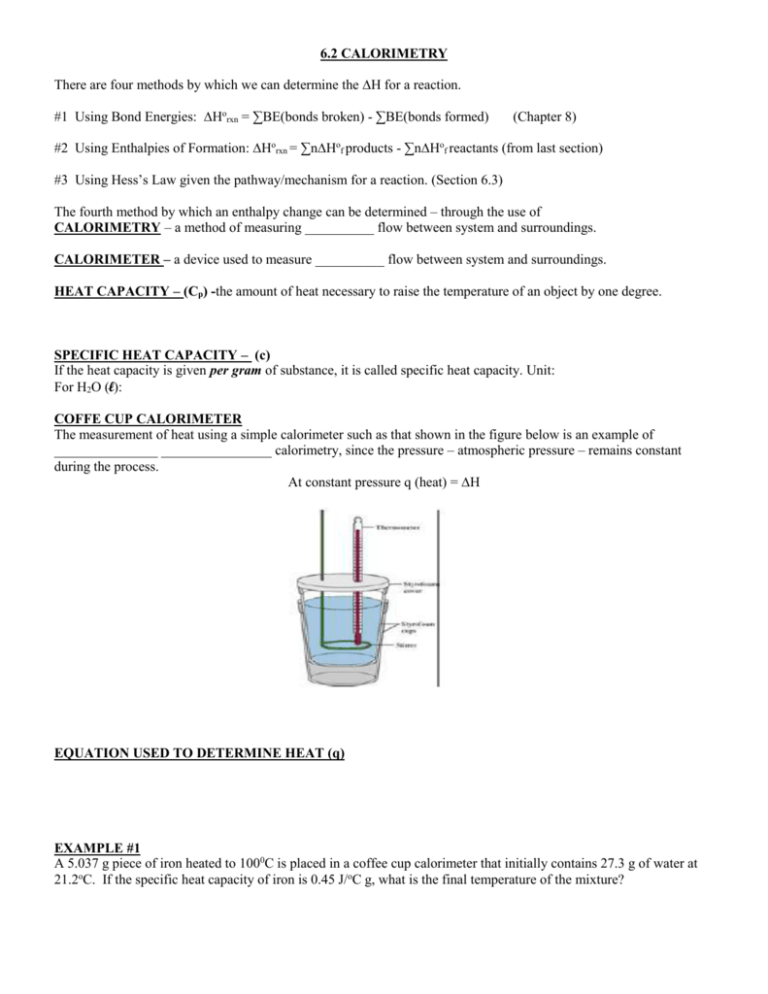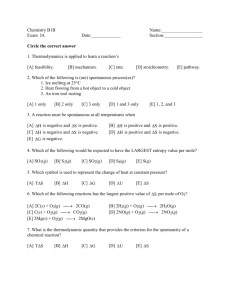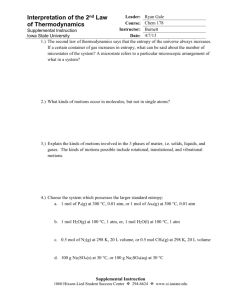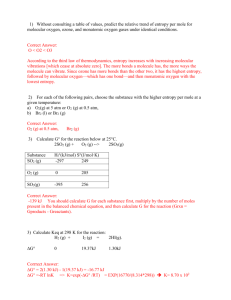Calorimetry, Entropy & Free Energy Worksheet
advertisement

6.2 CALORIMETRY There are four methods by which we can determine the ∆H for a reaction. #1 Using Bond Energies: ∆Horxn = ∑BE(bonds broken) - ∑BE(bonds formed) (Chapter 8) #2 Using Enthalpies of Formation: ∆Horxn = ∑n∆Hof products - ∑n∆Hof reactants (from last section) #3 Using Hess’s Law given the pathway/mechanism for a reaction. (Section 6.3) The fourth method by which an enthalpy change can be determined – through the use of CALORIMETRY – a method of measuring __________ flow between system and surroundings. CALORIMETER – a device used to measure __________ flow between system and surroundings. HEAT CAPACITY – (Cp) -the amount of heat necessary to raise the temperature of an object by one degree. SPECIFIC HEAT CAPACITY – (c) If the heat capacity is given per gram of substance, it is called specific heat capacity. Unit: For H2O (ł): COFFE CUP CALORIMETER The measurement of heat using a simple calorimeter such as that shown in the figure below is an example of _______________ ________________ calorimetry, since the pressure – atmospheric pressure – remains constant during the process. At constant pressure q (heat) = ∆H EQUATION USED TO DETERMINE HEAT (q) EXAMPLE #1 A 5.037 g piece of iron heated to 1000C is placed in a coffee cup calorimeter that initially contains 27.3 g of water at 21.2oC. If the specific heat capacity of iron is 0.45 J/oC g, what is the final temperature of the mixture? EXAMPLE #2 Suppose we mix 50.0 mL of 1.0 M HCl at 25oC with 50.0 mL of 1.0 M NaOH also at 25oC in a calorimeter. After the reactants are mixed by stirring, the temperature is observed to increase to 31.9oC. Calculate the ∆ Hrxn in kJ / mol of water produced. The density of the resulting solution is 1.02 g/mL. This problem is a two part problem. The first part is working with stoichiometry and the second is the thermochemistry part. STOICHIOMETRY PART Write the net ionic equation for the reaction: THERMOCHEMISTRY PART We have now found the mole part of the answer but we also need to know the heat (kJ) required to raise the temperature of a given amount of water by 1oC. Now use the appropriate data and calculate the heat released by the reaction in kJ/mol How much energy would have been released if twice these amounts of solutions had been mixed? The heat of a reaction is an __________________ property meaning it depends directly on the amount of substance used – in this case the amount of reactants. In contrast, an __________________ property is not related to the amount of substance. _________________ is an intensive property. NOTE: If two reactants at the same temperature are mixed and the resulting solution gets warmer, this means the reaction is __________________. An endothermic reaction __________ the solution. EXAMPLE #3 When 1.00 L of 1.00M Ba(NO3)2 solution at 25oC is mixed with 1.00L of 1.50 M Na2SO4 solution at 25oC in a calorimeter, the white solid BaSO4 forms and the temperature increases to 28.1 oC. Assuming that the calorimeter absorbs only a negligible quantity of heat, that the specific heat capacity of the solution is 4.18 J/ oC g, and that the density of the final solution is 1.00 g/mL, calculate the enthalpy change per mole (kJ/mol) of BaSO4 formed. 6.3 HESS’S LAW Another method to determine ∆H to determine is to use what is known as Hess’s Law. Since enthalpy is a state function (meaning it is pathway independent) – in going from a particular set of reactants to a particular set of products, the change in enthalpy is independent of the pathway taken by the reactants. This principle is known as Hess’s Law. In other words, Hess’s Law states that if a reaction is carried out in a series of steps, ∆H for the overall reaction will equal the sum of the enthalpy changes for the individual steps Example: 68 kJ + N2 (g) + 2 O2 (g) 2NO2 (g) One possible pathway (reaction mechanism) is the following: N2(g) + O2 (g) 2 NO (g) ___ _2NO(g) + O2 (g) 2 NO2 (g) Net reaction: N2 (g) + 2O2(g) 2 NO2 (g) ∆ H1 = 180 kJ/mol ∆ H2 = -112 kJ/mol ∆ Hrxn = 68 kJ/mol Intermediate – a species that is neither a product or reactant in the net reaction – is formed and consumed in the reaction process. In the above sequence, ___________ is an intermediate. Note: The above 2 steps represent one possible pathway by which the reactants become products. There can be multiple other pathways that give the same result. This is why enthalpy is a state function – independent of pathway taken. Practice Problem: Given the following data, calculate the ∆ Hrxn for the reaction: S (s) + O2 (g) SO2 (g) S (s) + 3/2 O2 (g) SO3 (g) 2SO2 (g) + O2 (g) 2SO3 (g) ∆ H = -395.2 kJ/mol ∆ H = -198.2 kJ/mol 2 characteristics of ∆ H for a reaction: 1) If a reaction is reversed, the sign of ∆ H is also reversed. 2) The magnitude of ∆ H is directly proportional to the quantities of reactants and products of the reaction. If the coefficients in a balanced equation are multiplied by an integer, the value of ∆ H is multiplied by the same integer. CHAPTER 6 HOMEWORK HOMEWORK – 2/15 (complete on separate sheet of paper) 1. In a coffee-cup calorimeter, 50.0 mL of 0.100 M AgNO3 and 50.0 mL of 0.075 M HCl are mixed. The two solutions were initially at 22.60oC, and the final temperature is 23.40oC. Calculate the heat that accompanies this reaction in kJ/mol of AgCl formed. Assume a density of 1.00 g/mL. 2. If 10.0 g of solid NaOH is added to 1.00 L of water at 25.0 oC in a constant pressure calorimeter, what will be the final temperature of the solution? NaOH(s) NaOH(aq) + 43 kJ HOMEWORK – 2/16 p. 285 #56,58 HOMEWORK – 2/17 None – make sure lab is turned in before you leave class today!! CHAPTER 16: SPONTANEITY, ENTROPY, AND FREE ENERGY 16.1 – SPONTANEOUS PROCESSES AND ENTROPY Entropy (denoted by symbol _____) – measure of the ____________________ or _________________ It is a state function. The natural progression of things is from ___________ to _____________, from _______________ entropy to _______________entropy. Spontaneous Processes – a process that occurs ____________ outside intervention. A driving force for a spontaneous process is an______________ in the entropy. A driving force for a spontaneous process is a ________________ in enthalpy. If both of these driving forces are present, a process is always ____________________. If both of these driving forces are absent, a process is always _____________________. If one driving force is present, and the other is absent, temperature will be a factor as to whether the process will be spontaneous or not (will discuss this more later in the chapter.) 16.2 ENTROPY AND THE SECOND LAW OF THERMODYNAMICS Second Law of Thermodynamics – Predicting the sign of ∆S +∆S means entropy is ____________________ -∆S means entropy is ____________________ Entropy _____________ with increases in temperature and volume. Entropy _______________ with the freedom of motion of molecules. Therefore S (g) ____ S (l) ____ S (s) Generally, when a solid is dissolved in a solvent, entropy _____________________. Examples: For each of the following pairs, choose the substance with the greater entropy a) N2 (g) at 273 K or N2 (g) at 373 K (same volume) b) N2 (g) at 1 atm or N2 (g) at 1.0 x 10-2 atm (same temp) Examples : Predict the sign of ∆S for the following a) Dry ice sublimes b) Sodium chloride crystals dissolve in water c) Nitrogen monoxide (g) + Oxygen (g) Nitrogen dioxide (g)









